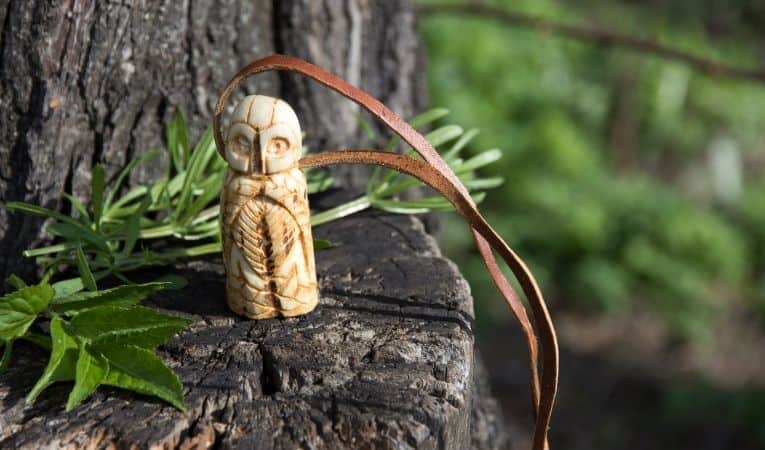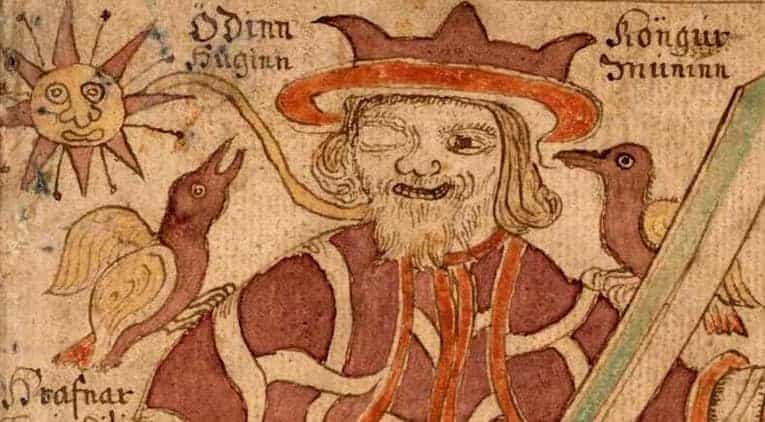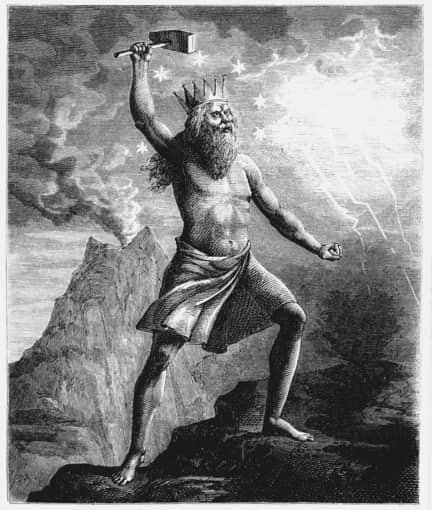Interest in the ancient Norse belief system of Scandinavia is rising in the twenty-first century.
Many people are generally aware that it was the religion of the Vikings, and most have probably heard of Norse gods like Odin and Thor.
Yet one of the most common questions people ask about Norse religion today is if it is still practiced.
Norse paganism, such as Asatru, has a small yet devoted band of followers in the 21st century. One well-established modern expression of the ancient Scandinavian religion is “Asatru.”
Some prefer the terms “Odinism” or “Heathenism,” yet the beliefs and worldview are largely the same.
Many people may be vaguely aware of the Norse belief system of ancient Scandinavia, which the Vikings, among others, adhered to and practiced.
Some may even be able to name a few Norse gods like Odin and Thor. But how are the various expressions of Norse paganism today the same, and yet different, than they were in the Middle Ages? Keep reading to learn more.
What do people do, say, or believe in order to become a Norse pagan or member of Asatru? See How People Convert to the Norse Religion to learn more.

Modern and Ancient Norse Religion: Comparison Chart
It’s important to understand what the ancient Scandinavians believed about unseen realms, the world around them, and the practices associated with those convictions.
After that, a person can compare modern expressions to ancient ones. (Also see Norse Paganism vs Christianity: What’s the Difference?)
Norse religion is still practiced today, but how is it different than those who practiced the faith during the Middle Ages? For example, some of the deities are the same — like Odin and Thor — but there are differences, too.
Ritualistic animal sacrifices were common in ancient Scandinavia, yet that practice is illegal in Western countries.
To begin to answer this question about similarities and differences, a general overview of basic ideas is helpful.
The chart below provides a starting point for understanding similarities and differences.
| Old Norse Religion | New Norse Religion | |
|---|---|---|
| known as | Norse religion, Norse mythology, Norse paganism, Germanic religion; original followers called it “Forn Sidr” or the “the old way” | Asatru, Odinism, Heathenry, Germanic Neopaganism |
| gods | Polytheistic (i.e. belief in many gods); there are gods and goddesses | Polytheistic; there are gods and goddesses |
| origins, influences | Ancient oral transmission, possible influences from shamanism* and animism** | Studying the Old Norse religion through history, art, archaeology, literature, and more |
| major time period | Ancient Scandinavia to the rise of Christianity in the 11th and 12th centuries | Revived in the 20th century and is ongoing in the 21st century |
| afterlife | The general belief in the afterlife, like Valhalla***, but no systematized doctrines | Beliefs vary, some people believe in Valhalla, but some don’t emphasize the afterlife at all |
| followers | unknown | Approximately 20,000 |
| location | Scandinavia | Mostly in Norway, Sweden, Denmark, and Iceland; small numbers exist in England and the U.S. |
Shamanism: Shamanism describes a belief system that centers on a person— called a shaman — who communicates with the spirit world. To communicate with the spirit world effectively, a shaman will often fall into a trance-like state of consciousness.
Animism: Animism describes a belief system that centers on the conviction that a spiritual essence permeates all things, such as animals, vegetation, bodies of water, mountains, people, and much more.
Valhalla: Valhalla in Norse paganism refers to a place in the afterlife that resembles a large medieval, building-life structure with a significant amount of open space and a large roof overhead.
In ancient Norse belief, Valhalla is located in Asgard and Odin himself rules over it. (Also see Is Valhalla Heaven or Hell? 10 Facts That Might Surprise You.)
Interested in Norse and Greek Mythology? Odin and Zeus are two of the most powerful gods in those belief systems. See Would Odin Beat Zeus in a Fight? to learn more.

What is Asatru?
Asatru is the name of a 20th-century revival of Norse paganism. The word “Asatru” combines the words “Asa,” which refers to Norse gods, and “tru,” meaning “faith.”
The word is commonly understood to mean “Æsir belief.” Æsir describes a particular category or subset of deities in Norse mythology. (Also see 25 Norse Gods to Know)
A note on names: “Asatru” is a common word in North America to describe certain modern expressions of Norse paganism.
However, some practitioners may prefer the name “Heathenry,” “paganism,” or something else. What may be considered correct, or preferred terminology may vary by region, group, or individual person.
Origin of Asatru: Sveinbjörn Beinteinsson (1924–1993), an Icelandic farmer, founded the modern Asatru faith. Since its inception, it has steadily grown and today can be found primarily in three places:
- Iceland
- Elsewhere in Scandinavia, like Norway, Denmark, and Sweden
- North America, particular in the United States and Canada; adherents are often of Scandinavian ancestry
Sacred texts: The literature of the Norse religion, including the Asatru faith, consists of the Icelandic Eddas, which date back to the 12th century A.D.
The Eddas include stories from Norse mythology. Other Icelandic poetry has also been found that contains stories of Norse gods like Odin, Thor, and Loki.
Norse goddesses play a significant role in the Norse belief system. See 10 Goddesses in Norse Mythology to Know to learn more.

Beliefs of the Norse and Asatru religion
Since there are no systematized doctrines in Norse paganism, there may be significant differences when it comes to the belief of its followers.
Originally, followers of Norse paganism were more unified in what they believed about gods, themselves, and the world.
Norse paganism today has more diversity. For example, some may believe in Norse deities and others may not. Some may focus on the spiritual realm in Norse paganism, while others may focus on the material realm.
Polytheism: The Norse belief system is polytheistic, meaning followers affirm the reality of multiple gods and goddesses. Certain gods and goddesses are more well-known than others and receive more attention in the worship and practice of those committed to the Asatru belief system.
Well-known Asatru gods:
(1) Odin – Odin is the ruler of Valhalla. He is also the god of poetry, riches, and more. (Also see Why Does Odin Only Have One Eye?)
(2) Thor – Thor is the ruler of the sky. He watches over the community.
(3) Freyr – Freyr is the god of fertility.
(4) Freyja – Freyja is the goddess of love and beauty. Freyr and Freyja are sisters. Thor and Freyja are married. (Also see Freyja: Goddess of Love, Witchcraft, and War to learn more)
Well-known god and goddess tribes: Some adherents of Asatru, like the ancient followers of Norse paganism, believe that there are major and minor gods.
Certain gods are more powerful than others; some are more relevant to people than others, and there are other differences as well.
As a result, people adopt a tiered approach to their devotion and interaction with various deities. Traditionally, there are three kinds of gods:
(1) Aesir – Aesir gods are those that belong to the principal race of gods; the well-known gods, Odin and Thor, belong to this group.
(2) Vanir – Vanir gods are those that are associated with the fertility of the earth and the forces of nature; Vanir gods, which include well-known figures like Freya and Freyja, were once in conflict with Aesir gods but were later allied with them.
(3) Jotnun – Jotnun figures describe as “any of a race of giants” who are perpetually at war with the Aesir. [2] (Also see The Giants of Norse Mythology: Who Are They?)
Most Asatru worship ancient Norse gods from different tribes. Generally, Aesir deities receive a lot of attention in their religious practices because of the popularity of certain gods in their clan.
The Asatru belief system has a small number of followers when compared to other religions, both ancient and modern. Despite this Asatru has survived for centuries, even when it wasn’t always visible or public:
“Thor and Odin are still going strong 1000 years after the Viking Age. Many think that the old Nordic religion—the belief in the Norse gods—disappeared with the introduction of Christianity.
However, it did not, but was instead practiced secretly or under a Christian cloak. Today there are between 500 and 1000 people in Denmark who believe in the old Nordic religion and worship its ancient gods.” [3]
A lot of people wonder what the Vikings looked like. See The Viking Dress Code: What They Wore and How to learn more.
Afterlife in Norse paganism and Asatru
The Norse religion contains a belief in life after death. However, there is no systematic doctrine on the subject.
The belief in Valhalla—a great hall or meeting place located in the afterlife for slain Viking warriors—was an important aspect of faith for many, but it’s impossible to know many understood it literally.
It is clear that not all Asatru believe in Valhalla. On priest of Asatru explains:
We believe that there is an afterlife, and that those who have lived virtuous lives will go on to experience greater fulfillment, pleasure, and challenge.
Those who have led lives characterized more by vice than by virtue will be separated from kin, doomed to an existence of dullness and gloom.
The precise nature of the afterlife—what it will look like and feel like—is beyond our understanding and is dealt with symbolically in the myths.
There is also a tradition in Asatru of rebirth within the family line.
Perhaps the individual is able to choose whether or not he or she is re-manifested in this world, or there may be natural laws which govern this.
In a sense, of course, we all live on in our descendants quite apart from an afterlife as such.
To be honest, we of Asatru do not overly concern ourselves with the next world. We live here and now, in this existence.
If we do this and do it well, the next life will take care of itself. [4]
Some modern-day expressions of Norse paganism do hold to the traditional beliefs of the faith, such as:
Valhalla: For Asatru that do believe in Valhalla, they likely hold the traditional teaching that Odin resides over the great hall, as the overlord for all slain Viking warriors deemed worthy enough to enter it.
Valhalla is depicted as a massive, open space within a walled structure with a tall roof, which is made of shields, providing protection and commemorating combat.
Vikings in Valhalla eat boar, which is killed every day, and then restored in the evening, in order to eat once more.
Haunting? Outside Valhalla, it was believed that the living and the dead could interact. Many followers held that the dead could positively or negatively impact those still living.
Some believed that the dead could haunt their living rivals, for example.
Burial: There was also the widespread practice of burying the dead with things that could help them in the afterlife, like valuable jewelry and even other people. Powerful men could be buried with ships, women, and gold.
Thor is a primary god in Norse paganism. See Who Can Lift Thor’s Hammer? Secrets of the Mjolnir to learn more.
Sacrifices and toasts in Norse paganism
In ancient Norse paganism, the practices of blot and sumbel were common.
Blot: Sacrifices called “blot” were common. Animals were the most common type of sacrifice.
They would be killed in ritualistic ways and their blood was used for ceremonial purposes, like sprinkling or smearing, which has symbolic purposes.
People could be sacrificed, too, like prisoners captured in battle. Asatru performs a version of blot today:
Our two main rituals are the blot and sumbel. “Blot” means sacrifice. While scholars debate whether or not it is connected with the word “blood”, we use mead (honey-wine), beer or cider today.
The liquid is consecrated to the God or Goddess being worshiped, and we commune with that Deity by drinking a portion of it. The rest is poured as a libation. [5]
Sumbrel: Sumbrel was a type of toast:
The Sumbel is a sort of ritualized toasting. The first of the usual three rounds is to the Gods, starting with Odin, who won the mead of poetry from the Giant Suttung.
It’s good to pour a few drops to Loki the trickster to ward off nasty surprises! The second round is to ancestors and other honorable dead. The third round is open. [6]
While beliefs are easy to duplicate even a millennium later — a Viking may believe in Thor and so many a modern man or woman — certain practices are more difficult to mimic.
As mentioned above, animal sacrifices, normal in ancient paganism, are illegal in the Western world today. In cases like this, old rituals are modified to suit modern sensibilities. (Also see Do Norse Pagans Pray?)
Community
Today, communities of Asatru are called Kindreds, Hearths, or Garths. Gatherings mostly occur outside, which follows the traditional ways of ancient Norse religion.
Yet ceremonies often involve eating and drinking rituals that symbolize the spiritual beliefs of the community. Sacrifices are also made, but most of the time they involve non-living things.
Controversy?
In recent years, racist groups have adopted some elements of ancient Norse paganism because they believe it reflects their worldview.
This has created controversy with those who argue that the belief system doesn’t teach that races of people are inherently unequal.
The Boston Globe recently reported the modern expressions of Norse paganism and raised the matter of white supremacy:
Of course, not all modern-day “heathens” (as some devotees call themselves) are looking for wisdom or emotional uplift.
The religion has made headlines in recent years thanks to another resurgent concept: white supremacy.
As it turns out, pagan gods’ names can be taken in vain too. Racists look at the Asgardian gods and see ultra-macho, ultra-white gods worshipped by white people.
In Norse paganism, anti-Semites see a religion that, unlike Christianity, is unconnected to Judaism.” [7]
Many racist groups and people root their convictions in a particular religion, though the religion doesn’t contain such doctrines.
For example, racist worldviews may claim a religion like Judaism or Christianity, but that doesn’t mean those belief systems have orthodox teachings that share that perspective.
Many religions and belief systems are hijacked for other people’s self-serving purposes. It is best to weigh claims on the historic and orthodox teachings of a particular faith over time to determine its views on a particular matter.
The Yggdrasil Tree is important in Norse Mythology. See What is the Norse Tree of Life? to learn more.

The history of Asatru
In one sense, the history of Asatru is the history of Norse paganism. The establishment of Norse religion is not a part of recorded history.
The earliest historical details known about it are reports on what observers saw and thought when they encountered it in ancient Scandinavia.
Some of the earliest mentions of Norse religion comes from historians like Tacitus who lived during the Roman Empire who were relying on other sources, such as traders and explorers, and later in time, Christian missionaries to Northern Europe.
Archaeological excavations have also unearthed items related to Norse religion, such as jewelry with charms decorated with beings and scenes related to the history and mythology of pagan beliefs.
As mentioned above, Asatru, a modern expression of the old Norse faith, was started by the Icelandic farmer Sveinbjörn Beinteinssn.
Beinteinssn sought to revive the old Scandinavian belief system, recruiting followers and writing poetry that reflected the Asatru worldview.
Germanic paganism declined at the end of the Viking age for multiple reasons:
- First, it wasn’t evangelistic, so there wasn’t an effort to proliferate it.
- Second, the Roman Catholic church was relentlessly determined to evangelize the inhabitants of Scandinavia. Their missionary efforts were sustained and well-funded.
Many Scandinavians converted to the Christian faith from the 10th to 12th century.
While some conversions may have been nominal — i.e. in name only, as opposed to being based on genuine changes in belief about God, the self, and the world—the paganism of the ancient world faded, though it didn’t disappear entirely.
Asatru recognition
In 1972 he petitioned the Icelandic government to recognize the Íslenska Ásatrúarfélagið, which translates to the “Icelandic fellowship of Æsir faith,” as a religious body.
The government approved the petition in 1973. Denmark and Norway have recognized the religion as well.
References:
[1] Source
[2] Source
[3] Source
[4] Source
[5] Source
[6] Ibid.
[7] Source
